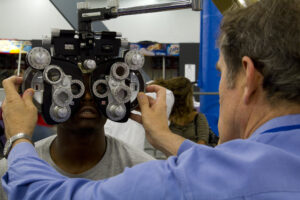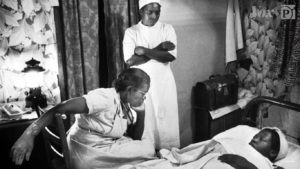Congress Health Care Is Not Real Reform
Two doctors from the Physicians for a National Health Program dissect the current government health care plan, arguing that the health care bills passed through Congress are not "real reform."
A copy of this interview is available at the PNHP website.
The PNHP recently interviewed Dr. David Himmelstein and Dr. Steffie Woolhandler, co-founders of Physicians for a National Health Program (PNHP), about the health bills emerging in Congress and the status of the movement for single-payer Medicare for All. Both are faculty members at Harvard Medical School and primary care physicians at Cambridge Hospital in Massachusetts. The telephone interview took place on Nov. 30, several weeks before the Senate adopted its version of the bill. On the eve of the Senate vote, PNHP called for the defeat of the bill, saying it would do more harm than good and that it would make genuine reform more difficult in the future.
PNHP: What’s your assessment of the health legislation that is emerging in Congress?
David Himmelstein: The bills are largely a sideways move. They will have very little impact on resolving or stabilizing the health care system. They improve things for some people and make things worse for some people.
For example, some poor patients or near-poor patients would benefit from federal subsidies for private insurance or by getting Medicaid, which they’re presently not eligible for. That would be an improvement.
However, patients who remain uninsured – and there will be at least 17 million of them – would probably see the resources available to them dwindle, because the bill takes part of its funding out of the hides of safety-net hospitals. Part of the proposed Medicare savings is derived from decreasing the funding for hospitals that care for a lot of poor, uninsured patients. So, for the remaining uninsured, the safety net would be even more threadbare than it is now.
Another example of an adverse impact: young people who have private coverage today would have to pay higher premiums because of the limits on premium differentials on age.
Almost no one would see an improvement before 2013 if the House version is passed, or 2014 if the Senate version passes. One thing is certain: the bills would entrench the insurance industry and pharmaceutical industry even further in their control of the health care system.
Steffie Woolhandler: I guess the way I’d summarize it is that some patients would be better off, some would be worse off, but what is completely clear is that this is not a solution.
DH: The private health insurance industry would be very much strengthened with $500 billion in new money coming their way, much of it in the form of public subsidy. And the pharmaceutical industry, similarly, would be getting more money – again, much of it from the public treasury. So those industries would be financially stronger.
PNHP: But aren’t the private insurers and Big Pharma complaining about the bills? Doesn’t that suggest there’s something positive for patients in them?
DH: The pharmaceutical industry hasn’t been complaining much, really – only a little around the edges. In fact they’ve been running television ads in some places supportive of the administration’s proposals. As for the insurance industry, they’ve traditionally taken the tack that they’ll never settle for half the pie. They always want the whole thing. They want the $500 billion in government subsidies without any of the very modest incursions on their business practices that are in the bills today.
PNHP: To what extent does the national legislation follow the Massachusetts model?
SW: I think the national plan is like Massachusetts. If anything, the national plan is a little bit worse, in that in during the first three years of the reform in Massachusetts, the insurance exchange offered only nonprofit subsidized plans. The national bill will mostly offer for-profit plans, maybe exclusively so.
The other thing is that the Massachusetts plan went into effect right away, so whatever benefits it contained were actually there at the beginning – you didn’t have to wait three or four years for them to kick in.
Yet another difference, according to press reports here, is that the subsidies in the national bill are likely to be lower than they are in Massachusetts. I haven’t seen the details on that, but that’s what’s being reported. The subsidies in the national bill will be less than what we presently have in the state.
DH: Keep in mind also that Massachusetts started from the vantage point of having the lowest uninsurance rate in the country. The 2006 reform cut it roughly in half. We also had and still have a tradition of quite generously funding the safety net in the state, although that’s been cut back as part of the state legislation. So the access to care was better in Massachusetts than almost anywhere else in the country before the reform.
We won’t be starting from nearly as good a position nationally, so what we arrive at on the national level is certainly not going to be as good as what we’ve got in Massachusetts.
That said, on the ground in Massachusetts things are not so rosy. We still have more than 300,000 people uninsured in our state and face grave difficulties in getting care for them. In fact, access to care for them is worse now than before the reform was passed, because the institutions that provide care for the uninsured have seen very sharp funding cuts.
We’re now beginning to see cutbacks in coverage because of the very high costs of implementing the plan. Some 30,000 immigrants – these are legal immigrants – have seen their rights to care sharply cut. Co-payments have risen and premiums are continuing to rise quite sharply in the state. A number of patients who were entitled to free care under the old Massachusetts free care system now face quite steep out-of-pocket costs.
The other thing worth saying is that the Massachusetts reform has done nothing for the vast majority of people who had insurance at the outset but were strained financially by the premiums and out-of-pocket costs. They continue to face great difficulty.
So, after an improvement in the first year in access to care in Massachusetts, things have now started to reverse. And the fiscal strains on the state and the program promise to make things even worse in the near future.
PNHP: How much has the Massachusetts reform cost? Is the plan financially solvent?
SW: That’s a very politically contested subject. The actual cost of the state reform is one of those very hot-button numbers. If you include the total cost to everyone in the state, public or private, you’re looking at a figure about $1 billion a year higher than it would have been without the reform. So public and private costs combined have been driven up health spending by more than a billion annually.
DH: The Congressional Budget Office estimates that nationally it costs $4,000 to insure someone, and I think that’s likely true in Massachusetts as well. The reform insured about 300,000 people, so you get a figure like $1.2 billion, but exactly where those costs have fallen is very difficult to track down because the state budget has obfuscated that enormously.
There’s also been a large dollop of federal money coming into the state in partial support for the plan. State officials claim, “We’ve only spent $300 million or $400 million a year on it,” but that excludes the federal funding. And, as part of the stimulus package, there was actually an increase in the federal matching rate for Medicaid – it went from 58 percent to 62 percent of every Medicaid dollar coming in from federal sources – and that wasn’t just for the newly insured, that was for all Medicaid patients.
So there’s been a large infusion of new federal funds that have helped to keep the plan afloat. Exactly how much of that is attributable to the reform is hard to track down. And as to private spending, we won’t have exact figures on that for another year or two, because the state doesn’t really track it and the feds won’t have their numbers out for another year or two.
PNHP: How do you reply to people who say, “Yes, the bill that’s emerging in Congress is flawed, but it’s a start and it can be improved upon later, just like Medicare was”?
DH: Historically, the way we’ve made progress in health reform has not been by incremental steps, but by major steps at propitious moments that often, in the ensuing years, get eaten away.
We haven’t actually been able to enlarge on many improvements in Medicare, and it has really been largely eroded since it was first passed, not pushed forward.
SW: Medicare has certainly been eroded since the late 1970s. After it was passed and the program took form, Congress actually extended Medicare to two additional groups in the 1970s – people with end-stage renal disease and people who have been totally and permanently disabled for more than two years. But in terms of what the program offers, it was never actually improved on, and even in terms of the number of people covered, there have been no improvements since the late ’70s, just an erosion of it.
DH: And whereas Medicare was a fully public program at the outset, the “private option” has been added to Medicare in the last few decades. It’s gone from being a sort-of-single-payer system for the elderly to being a public option program that is unfairly competed against by private insurers who receive extra government subsidies.
PNHP: But some people say that, politically speaking, the Obama administration needs to have a victory on this front, even if it is imperfect. It’s the administration’s momentum that’s important. What do you say to that?
SW: I think there’s two ways for the Obama administration to fail. One way would be to fail to pass any legislation, and the other would be to pass legislation that is worthless, that doesn’t solve the problem.
If you don’t pass legislation, at least you can blame the Republicans the next time around. If you pass something that doesn’t solve the problem, you’ve failed and plus you’re in much worse shape than you would have been otherwise.
DH: It’s like saying if Roosevelt had passed a fake Social Security bill, that that would have sustained the momentum of the Roosevelt administration. In fact, people would have eventually understood that a fake Social Security bill wasn’t real. Similarly, people will understand in 2014, when this bill finally comes into effect, that the Democrats passed a piece of legislation that was nearly worthless. To stake the future of progress on a piece of Potemkin-village-like legislation, a fake front, is a dangerous game to play.
PNHP: What’s your reaction to the Stupak amendment in the House bill restricting insurance coverage for abortion?
DH: It’s completely unacceptable as part of the bill and it signals several things. One is that the right has been perfectly willing to hold people hostage to its ideology, whereas progressives by and large have not. But the second is that, under any health reform, we’re going to have a huge fight to preserve the right to choose. That’s going to be true under single payer as well: we’re going to have to defend the right to choose over and over again and keep pushing on.PNHP: Some people say we should embrace a highly regulated system like Switzerland or Germany has instead of adopting single payer. Others suggest gradually lowering the eligibility age for Medicare as a stepping stone to single payer.
DH: These proposals are based on the presumption that politically it’s easier to do lesser measures than single payer. I think the behavior of the insurance industry in the current round of debate suggests that’s actually a false precept. Even the most minor regulations have evoked enormous opposition from the insurance industry.
So, for example, the view that we can completely change the nature of the insurance industry but leave them in the health care system and that that’s going to mollify them – that we’re going to turn them into extraordinarily tightly regulated, not-for-profit organizations whose executives can’t be paid extraordinary sums, whose shareholders receive no compensation, whose behavior is really completely different than their behavior today and that somehow that will attenuate their political opposition – I mean even the most minor regulations in the current bill have been enough for them to come out and oppose it, despite getting an extra $500 billion from it.
I think the view that, politically, we head off their opposition in this way is demonstrably incorrect. This gives rise to two additional questions. First, if the opposition from the insurance industry to these lesser measures is every bit as strong as it is to single payer, are we likely to enlist a much larger number of people to win that sort of reform? I think answer to that is, probably not. There’s not a strong principled group of people saying, “We want a German-style system rather than national health insurance.”
The second question is: Does it work better as policy? That is, which system ultimately works better once you get it in place? There I think the answer is demonstrably clear that in a single-payer system you get more and better care for people than any given amount of money you spend than under one of these regulated systems like what T.R. Reid has been speaking about, for example the German system or the Swiss or Dutch systems.
The political compromise that some people suggest doesn’t get you very far politically, and the policy compromise gets you a worse health care system.
On reducing the Medicare eligibility age to 55, where it’s done automatically for everyone in that group (as opposed to a so-called buy-in, which would create very big problems), in some ways it’s a similar calculus. Do you really substantially reduce the political opposition? I would say probably not. The policy is a little different, because it’s a better policy than going to a regulated system, but the problem there is that until you get everybody in, you don’t get many of the financial advantages of a single-payer system. And as you phase it in, you’re adding money in order to keep the system afloat and only at the end of that process do you get the savings that make it financially viable. So the phase-in is really a big problem.
PNHP: What should supporters of single-payer health reform be doing during this period?
DH: One very important task for single-payer people is to make it clear to others that this bill is not ours, and that this reform is not real health reform. Then, when it’s passed and fails, we need to make it clear that Congress and the administration never did health reform, not that health reform didn’t work.
Until the bill is finished being debated, the one piece of salvage that would be worthwhile at this point would be for Congress to adopt an amendment allowing individual states to experiment with their own single-payer systems should they choose to do so. Rep. Dennis Kucinich is trying to get his state single-payer amendment back into the bill; Sen. Bernie Sanders has something similar on the Senate side. The message to our lawmakers would be something like, “We think this is a horrible bill. Can’t you at least get the option for our state to do better?”
PNHP: Are you worried that the single-payer movement will turn away from national legislative efforts and instead focus on state-based campaigns?
SW: I don’t worry about that because the state work and national work are complementary. I think we do need a national single-payer bill, so I hope people don’t think we should abandon the idea of national reform. But working at the state level can help build the knowledge and movement that can get us to single payer nationally.
DH: Steffie is from Louisiana and, as she’s fond of reminding me, if Louisiana is ever going to have decent health care program, we can’t do it state by state.
PNHP: How would you assess PNHP’s and the single-payer movement’s efforts in this round of reform? What has been most effective in advancing cause – lobbying, testimony before Congress, civil disobedience, rallies? What lessons do you draw?
DH: All of those things have been effective, except for the testimony, to be honest. The testimony is the result, not the cause, of such activity. When Congress asks people to come testify, that’s a signal that they’ve been getting pressure from below.
The mobilization in communities around the country, particularly some of the dramatic activities like civil disobedience and the Mad as Hell Doctors’ caravan – especially when they attracted media attention – have been quite effective.
But I think that the lesson is that we haven’t built nearly a big and strong enough movement. And it’s not just in health care, frankly – we need a movement that takes back the country in many respects and that goes beyond health care. Health care is going to be an important part of it, but I think having organizations throughout the nation that are pressuring our political leaders in a much more serious way than we’ve even been able to do in this round of pushing for single payer is clearly going to be essential. That’s the message for us now, and if the next debate about health reform is five or seven years from now, that’s how long we have to really build a movement five times as large as what we have.
SW: It will take a much bigger movement to take back power from the corporations, who are now actually running the country.
DH: The nation’s political process needs to be responsive not just to corporate power. And at some level single-payer forces should unite with folks who say we need much more regulation of the financial sector, for example, and of many other aspects of life.
PNHP: Has PNHP been growing and if so, why?
DH: PNHP has been growing. Doctors have a different perspective on this than politicians. We’re in this for our whole careers, and the fact that the health reform debate may die down for a couple of years doesn’t actually mean we go on to another issue.
We’re in this issue for life, and if the health care system would let us do our work and accomplish with our patients what we want to accomplish then the need for PNHP would evaporate and we would close down. But unfortunately that need continues to mount. That means that doctors – more and more of us – feel the need to be active. And that’s not going to go away when the Congress stops debating this issue actively.
Yes, there will be some disappointment if a bad bill is passed, and a feeling of regret that the issue is not being debated as actively as one would want, but I think within the medical profession it’s clear that the urge for reform is going to continue and likely strengthen through time because the situation is continuing to get worse for our patients and our work.
PNHP: What’s behind PNHP’s tenacity for these 20-odd years?
SW: I think the health system’s problems have continued and in some ways mounted, but our members are people who actually work every day in health care, so it’s not like people move on to some issue like world peace, however valuable that might be. These are people whose lives are in the health care system, trying to take care of patients.
DH: We actually don’t have alternatives. One can work on world peace and on issues we face in our everyday work, but unless you’re going to say, “Well, I spend 55 hours a week in a terrible health care system and I’m going to ignore that,” I think doctors of conscience increasingly feel driven to do something about the distortion and corrosion of their work.
PNHP: You’ve been extremely prolific in your research this year, publishing seven or eight studies, including one showing that 62 percent of personal bankruptcies are linked to medical bills or illness, and another showing that 45,000 deaths annually are linked to lack of health insurance. How do you evaluate the impact of this work?
DH: The research is the product of a research team that includes several colleagues — Andy Wilper, David Bor, Danny McCormick and (for the bankruptcy study) Deborah Thorne and Elizabeth Warren. Obviously the circumstance of the nation being very actively focused on health reform is part of the reason why the research has received so much media attention.
But while we’re gratified that the work has been useful in helping to open debate, the actual use of the findings by politicians – the arguments that they’ve made with the data – have often been very disappointing.
I think Steffie has remarked that the work has helped push the wagon of health reform forward, but someone else has been steering the wagon in a very different direction than we would want it to go.
We’ve tried to highlight the major problems in the health care system and some of the reasons why the alternatives to single payer won’t work. The pieces that highlight the irrationality and the problems of the health care system have gained attention, but the pieces that speak to why the alternatives won’t work have been selectively ignored.
SW: Some politicians love to bring in the left or the left-liberals to create research and create a movement and create some energy, but that’s pretty different from then putting you in charge of things and letting you make decisions.
PNHP: Are there any final comments you’d like to make?
DH: One thing that has been striking in this year’s push for single payer has been the tremendous degree of cohesion and the sense of camaraderie within PNHP. That’s somewhat different than the feeling during the 1993 round of health policy debate, where there was more controversy within PNHP and, frankly, within the single-payer movement. At that time, some colleagues were saying we had to stop pushing for single payer and hop on board the Clinton health plan.
There’s been a very clear-eyed sense and consensus within the organization that our role is to say what’s right in this debate and to bring forward a principled stance and not to play political games that end up with disastrous consequences.
It’s also gratifying to see how PNHP has helped create a platform for people to speak in their communities and speak in public and really use their creative energies in a progressive way on health policy, as has been amply demonstrated in this round of debate. There’s no way we could have raised enough money to do the work that PNHP members have done on a volunteer basis. The organization is there to provide resources and opportunities to work, and our members have taken advantage of those opportunities in extraordinary ways.
Your support matters…Independent journalism is under threat and overshadowed by heavily funded mainstream media.
You can help level the playing field. Become a member.
Your tax-deductible contribution keeps us digging beneath the headlines to give you thought-provoking, investigative reporting and analysis that unearths what's really happening- without compromise.
Give today to support our courageous, independent journalists.






You need to be a supporter to comment.
There are currently no responses to this article.
Be the first to respond.